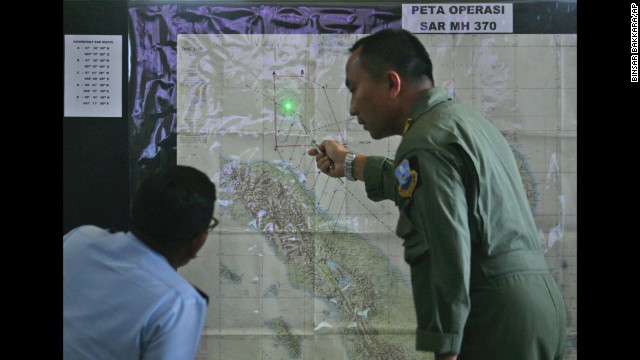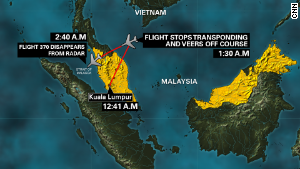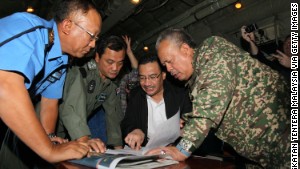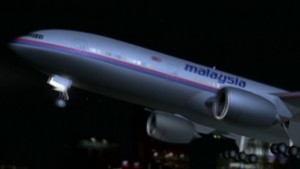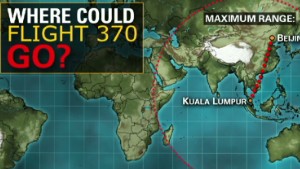Malaysia Airlines Flight 370
From Wikipedia, the free encyclopedia
Malaysia Airlines Flight 370 (MH370/MAS370), also marketed as
China Southern Airlines Flight 748 (CZ748) through a
codeshare, was a scheduled passenger flight from
Kuala Lumpur, Malaysia, to
Beijing, China. On 8 March 2014, the
Malaysia Airlines Boeing 777-200ER
operating the flight disappeared with 227 passengers of 15
nationalities and 12 crew members on board, following its last contact
with
air traffic control less than an hour after take-off.
A joint
search-and-rescue effort covering an area of 27,000 sq mi (70,000 km
2) in the busy
[1] Strait of Malacca and the
South China Sea[2]
is being conducted by more than 12 countries. Vietnam briefly reduced
its efforts on 11 March, but the search area continued to expand and
searchers began to look for evidence on land.
[3][4][5][6]
Two passengers boarded the aircraft using stolen passports raising initial concerns that terrorism may have been involved.
[7] Malaysian police later identified both passengers and said that they were 'unlikely' to be terrorists.
[8]
Incident
The flight departed from
Kuala Lumpur International Airport on 8 March at 00:41
local time (16:41
UTC, 7 March) and was scheduled to land at
Beijing Capital International Airport at 06:30
local time (22:30 UTC, 7 March). It ascended to its assigned
cruise altitude of 35,000 feet (10,700 m) and was travelling at 471 knots (542 mph; 872 km/h)
true airspeed when it ceased all communications and the
transponder signal was lost. The aircraft's last known position was
6°55′15″N 103°34′43″E, corresponding to the navigational
waypoint
IGARI, at which the aircraft was due to alter its course slightly
eastward. The aircraft was also expected to contact air traffic control
in
Ho Chi Minh City as it passed into Vietnamese airspace just north of the point where contact was lost.
[9][10]
Malaysia Airlines issued a media statement at 07:24 confirming that contact had been lost at 02:40 and that
search-and-rescue operations had begun.
[11]
It later emerged that Subang Air Traffic Control had lost contact with
the aircraft at 01:22 and notified Malaysia Airlines at 02:40.
[12] Neither the crew nor the aircraft's onboard communication systems relayed a
distress signal, indications of bad weather, or technical problems before vanishing from radar screens.
[13] The airline reported in its eleventh press release that all its aircraft are fitted with
Aircraft Communications Addressing and Reporting System
(ACARS), a system that automatically transmits data about the status of
the aircraft, but added "Nevertheless, there were no distress calls and
no information was relayed."
[14]
Search
Location
The search efforts generated multiple false leads. An admiral of the
Vietnamese Navy reported that radar contact with the aircraft was last made over the
Gulf of Thailand,
but it transpired that this result corresponded to the loss of radar
contact by Subang air traffic control rather than the discovery of a
crash site.
[12] Oil slicks
were located off the coast of Vietnam on 8 and 9 March and were thought
to have possibly arisen from the aircraft. Test results reported on 10
March indicated that the oil slicks did not contain aviation fuel.
[15][16] There were reports that a door or other fragment of the aircraft was found about 80 km (50 mi) south of
Thổ Chu Island on 9 March. The following day, the
Department of Civil Aviation Malaysia reported these claims were untrue; the floating material was not from an aircraft.
[17]
The
Royal Thai Navy
shifted its focus in the search away from the Gulf of Thailand and the
South China Sea at the request of its Malaysian counterpart, which is
investigating the possibility the aircraft turned around and could have
gone down in the
Andaman Sea, near Thailand's border.
[18] The chief of the
Royal Malaysian Air Force, Rodzali Daud, claimed that military recordings of
radar signals did not exclude the possibility of the aircraft turning back on its flight path.
[19][20] The search radius has been increased from the original 20 nautical miles (37 km; 23 mi) of its last known position,
[21] south of Thổ Chu Island, to 100 nautical miles (190 km; 120 mi), and the area now covers the seas to the
Strait of Malacca along the west coast of the
Malay Peninsula,
with waters both to the east of Malaysia in the South China Sea, and in
the Strait of Malacca along Malaysia's west coast, being searched.
[22][2][23]
On 11 March, it was reported that military radar indicated the
aircraft turned west and continued flying for 70 minutes before
disappearing near
Pulau Perak;
[24][25] it "changed course after
Kota Bharu
and took a lower altitude. It made it into the Malacca Strait". This
last location is approximately 500 km (311 mi) from its last position in
contact with air traffic control.
[26]
However, the next day Rodzali Daud denied making the statements as
reported in the media, requesting that the misreporting be "amended and
corrected to prevent further misinterpretations of what is clearly an
inaccurate and incorrect report".
[27][28] Vietnam has scaled back its search operations to await clarification from Malaysia due to the conflicting reports.
[29]
On 12 March, authorities also began to search the Andaman Sea, north
of the Strait of Malacca, and the Malaysian government requested help
from India to search in the area.
[30]
Response

Australian RAAF AP-3C Orions are participating in the search.

RSS Steadfast from Singapore

The Vietnam Coast Guard CASA C-212-400
|
In response to the incident, the Malaysian government mobilised the
Civil Aviation department, Air Force, Navy and Maritime Enforcement
Agency, and requested international assistance from
Integrated Area Defence System (IADS) and neighbouring states. Various nations mounted a search and rescue mission in the region's waters.
[31][32] The countries have dispatched a total of 34 aircraft and 40 ships to the area.
[3][2][23] Qatar offered assistance, and the French agency for investigating aircraft crashes, the
Bureau d'Enquêtes et d'Analyses pour la Sécurité de l'Aviation Civile (BEA), offered to help with any underwater search and recovery operation.
[33][34] The
Comprehensive Nuclear-Test-Ban Treaty Organization Preparatory Commission tried, but failed, to use its network of
infrasound detection stations to find any sounds made by this flight.
[35] Assets sent by different nations include:
- China: 5 Navy warships, Type 071 amphibious transport dock Jinggang Shan,
with 2 helicopters, 30 medical personnel, 10 divers, and 52 marines, as
well as life-saving and underwater detection equipment on board,[44] amphibious transport dock Kunlun Shan with 2 helicopters and 50 marines, Type 052C destroyer Haikou with 1 helicopter,[45] Type 053H3 frigate Mianyang with 1 helicopter and replenishment ship Qiandaohu, 3 Chinese Maritime Safety Administration ships: Hai Xun 31
a large patrol vessel with 1 helicopter and underwater scanning
equipment, South Sea rescue No.101 and No.115 large search and rescue
vessel in the area. Coast Guard No.3411 large patrol vessel and COSCO
Merchant ship Tai Shun Hai. China has also retasked ten orbiting defence satellites over the area.[46]
- Thailand: A Navy Super Lynx helicopter and a patrol ship. Two other ships are on standby in the Gulf of Thailand.[60][61][62]
- Vietnam: three Antonov An-26, two CASA C-212, one DHC-6 Twin Otter, three Mil Mi-171,
and nine ships from the Navy (HQ-954, HQ-637, HQ-627, HQ-888), Coast
Guard (CSB-2001, CSB-2003), Fisheries Control (KN-774), and Maritime
Search & Rescue Coordination Centre (SAR-413, SAR-272).[68][69]
Aircraft

The cockpit of 9M-MRO in 2004
Flight 370 was operated by a
Boeing 777-2H6ER,
[a] serial number 28420,
registration
9M-MRO. The 404th Boeing 777 produced, it first flew on 14 May 2002,
and was delivered new to Malaysia Airlines on 31 May 2002. The aircraft
was powered by two
Rolls-Royce Trent 892 engines,
[71] and was configured to carry 282 passengers: 35 in business class and 247 in economy class.
[72] According to the airline, it had accumulated 53,460 hours and 7,525 cycles in service.
[73] 9M-MRO had not previously been involved in any major incidents;
[74] a minor incident while taxiing at
Shanghai Pudong International Airport
in August 2012 resulted in significant damage to one of its wingtips,
which broke off after striking the tail of another airliner.
[75] Its last maintenance check was in February 2014, which is 12 days before the incident.
[73]
The Boeing 777 is generally regarded by aviation experts as having an "almost flawless" safety record,
[76] one of the best of any commercial aircraft.
[77]
Since its first commercial flight in June 1995, there have only been
two previous serious accidents. In January 2008, 47 passengers were
injured when ice crystals in the fuel system of
British Airways Flight 38 caused it to lose power and crash-land just short of the runway at
London Heathrow Airport. In July 2013, three passengers died and 181 were injured as a result of that accident when
Asiana Airlines Flight 214 crash-landed on final approach to
San Francisco International Airport.
[78] Both aircraft were
damaged beyond repair.
[79]
Passengers and crew
Nationalities of people aboard Flight 370
 Australia Australia |
6 |
|
6 |
 Canada Canada |
2 |
|
2 |
 China China |
152 |
|
152 |
 France France |
4 |
|
4 |
 Hong Kong[80][81] Hong Kong[80][81] |
1 |
|
1 |
 India India |
5 |
|
5 |
 Indonesia Indonesia |
7 |
|
7 |
 Iran[b] Iran[b] |
2 |
|
2 |
 Malaysia Malaysia |
38 |
12 |
50 |
 Netherlands Netherlands |
1 |
|
1 |
 New Zealand New Zealand |
2 |
|
2 |
 Russia Russia |
1 |
|
1 |
 Taiwan Taiwan |
1 |
|
1 |
 Ukraine Ukraine |
2 |
|
2 |
 United States United States |
3 |
|
3 |
| Total |
227 |
12 |
239 |
Malaysia Airlines released the names and nationalities of the 227 passengers and 12 crew, based on the
flight manifest.
[83]
Crew
All the crew members were Malaysian. The
captain was 53-year-old Zaharie Ahmad Shah from
Penang, who joined Malaysian Airlines in 1981 and had 18,365 hours flying experience.
[84] Zaharie was also an examiner qualified to conduct simulator tests for pilots.
[85] The
first officer was 27-year-old Fariq Abdul Hamid, an employee of Malaysia Airlines since 2007, with 2,763 flying hours.
[86][87] Fariq recently switched to flying the Boeing 777-200 after completing his simulator training.
[87]
Passengers
The majority of the passengers (152 of 227) were Chinese citizens.
Thirty-eight passengers and all twelve members of the crew were
Malaysian. The remaining passengers came from thirteen different
countries. The Chinese passengers included a group of nineteen artists
with six family members and four staff, returning from a calligraphy
exhibition of their work in Kuala Lumpur.
[88] Twenty of the passengers were employees of
Freescale Semiconductor, a company based in
Austin, Texas. Twelve of these employees were from Malaysia and eight from China.
[89]
Malaysia Airlines has also sent a team of caregivers and volunteers dubbed
GoTeam to provide assistance towards family members of the passengers.
[90]
In its press releases, the carrier stated that it would bear the
expenses of bringing family members of the passengers to Kuala Lumpur
and providing them with accommodation, medical care, and counselling.
[91]
It was reported that only 10 percent of Chinese passengers' families
took up the offer to travel to Malaysia; some were sent to India via
Hong Kong, and some in Indonesia have said there is little help being
offered to them.
[92] The airline offered an
ex gratia condolence payment of $US5,000 to the family of each passenger,
[93] but relatives considered the conditions unacceptable and asked the airline to review them.
[94]
Two press releases by the airline on 12 March dealt with the care
offered to relatives of passengers. 115 family members and 72 caregivers
are in Kuala Lumpur and 112 caregivers in Beijing were provided for an
unknown number of people.
[95]
A psychologist, Paul Yin, who had a friend on the flight, was working
with families in Beijing. He said he thought many had stayed so they
could remain close to those who could support them; they would have felt
isolated in Malaysia. He described the challenges he and others faced,
with many holding to a "thin ray of hope," but he felt it was important
for people to prepare for any outcome, saying he did not want to "set
them up for a bigger fall."
[96]
Investigation
Boeing has announced that it is assembling a team of experts to provide technical assistance to investigators,
[97] in accordance with
International Civil Aviation Organization (ICAO) protocols. In addition, the United States
National Transportation Safety Board announced in an 8 March press release that a team of investigators had been sent along with technical advisers from the
Federal Aviation Administration to offer assistance in the investigation.
[67] The country that will lead the investigation will not be determined until the missing aircraft is found.
[98]
Because a formal (ICAO-sanctioned) investigation has not yet kicked
off, cooperation and coordination between involved parties could suffer,
there being "a risk that crucial early detective work could be
hampered, and potential clues and records lost", according to experts.
[99]
The United States
Federal Bureau of Investigation has deployed technical experts and agents to investigate the disappearance.
[100] However, a senior US law enforcement official clarified that FBI agents were not sent to Malaysia.
[101]
United States and Malaysian officials are reviewing the entire
passenger manifest in addition to the two passengers who were confirmed
as possessing stolen passports.
[102]
Stolen passports
At least two of the passengers were travelling with passports stolen
from citizens of European countries. Two men identified on the manifest,
a 30-year-old Austrian and a 37-year-old Italian, had reported their
passports stolen in 2012 and 2013, respectively.
[12][103] Interpol
stated that both passports were listed on its database of lost and
stolen passports, but that no check had been made against its database,
noting that very few countries consistently use the database.
[104][105] Malaysia's Home Minister,
Ahmad Zahid Hamidi, criticised his country's immigration officials for failing to stop the passengers travelling on the stolen European passports.
[105]
The two one-way tickets purchased for the holders of the stolen passports were booked through China Southern Airlines.
[106] It was reported that an Iranian had ordered the cheapest tickets to Europe via telephone. The tickets were paid for in cash.
[107][108][109] A Thai police chief suggested that the tickets were bought for illegal Iranian migrants.
[110]
The two passengers were later identified as Iranian men, one aged 18
and the other 29, who both entered Malaysia on 28 February using valid
Iranian passports. The head of Interpol said they were "inclined to
conclude that it was not a terrorist incident".
[82][111][112][7]
Officials' communication with the public
Communication between official representatives of many organisations
and the public regarding the loss of the flight has been hindered by
misinformation, and there are now doubts as to the aircraft's possible
location and trajectory.
[113][114][115] Australian
crisis management
expert Mike Smith believes that although the initial stages had been
well-managed by Malaysia Airlines, the increasing numbers of government
officials commenting publicly created confusion. Smith suggested that,
as the disappearance became of international concern, the Malaysian
government failed to take control and to establish an emergency crisis
control point where the information could be disseminated in a
responsible and truthful manner. Smith pointed to contradictions,
apparent "finger-pointing, rumours and innuendo ... from Malaysian
officials, whose motives we can only speculate about"


